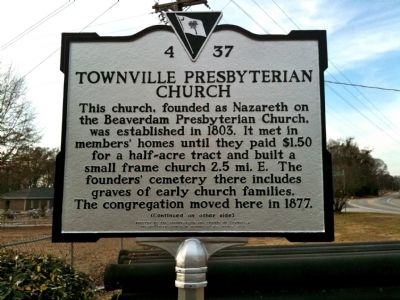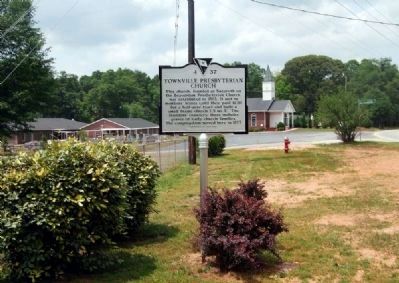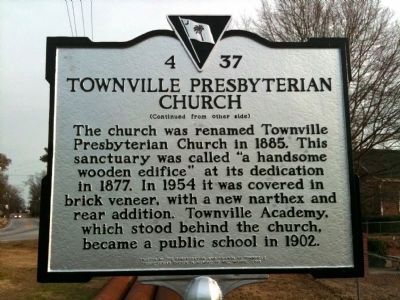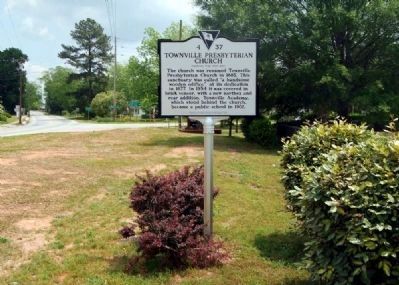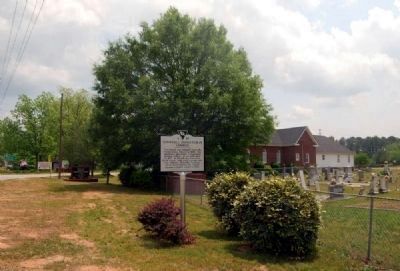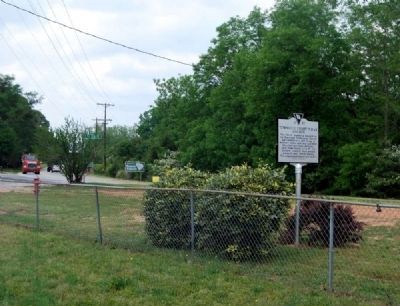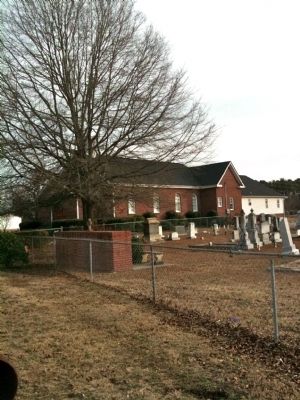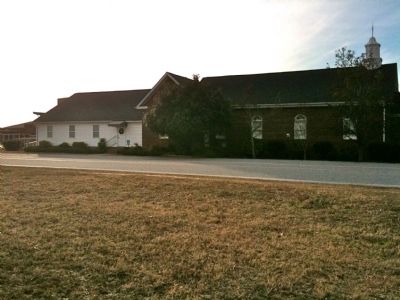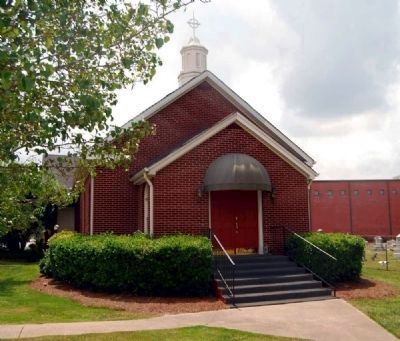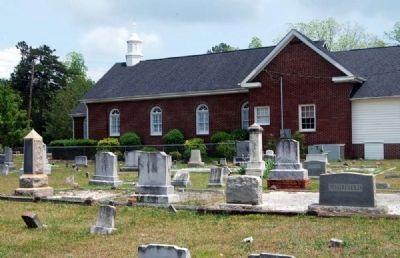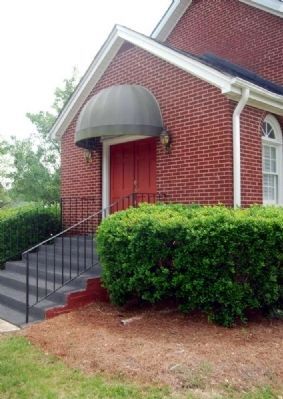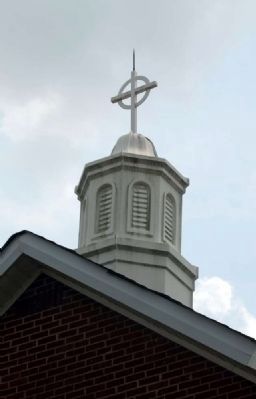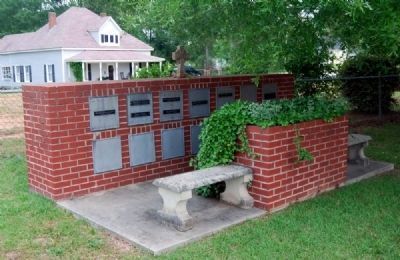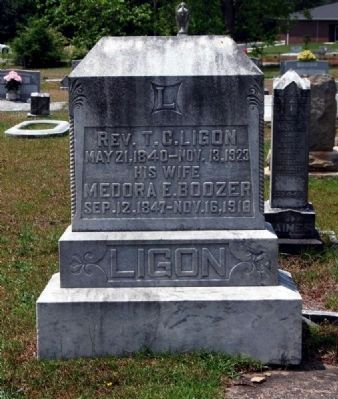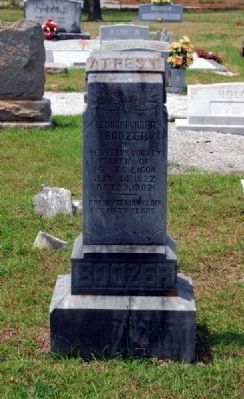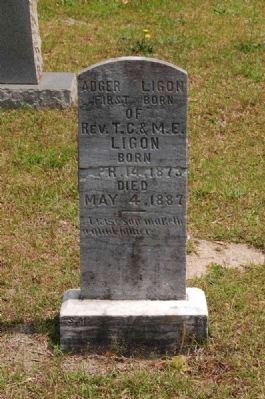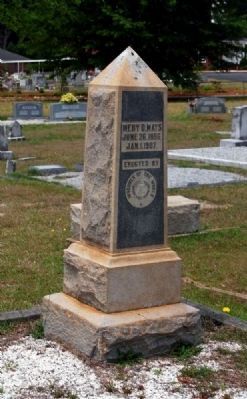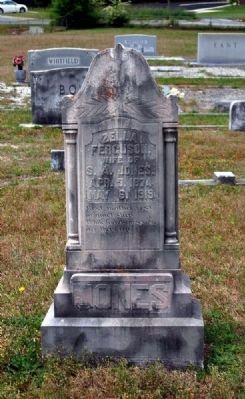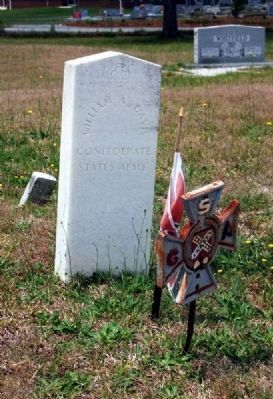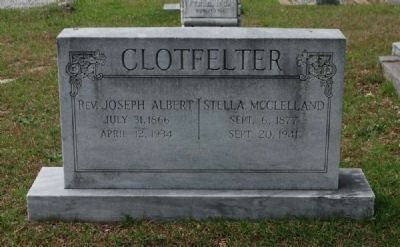Townville in Anderson County, South Carolina — The American South (South Atlantic)
Townville Presbyterian Church
[Front]
This church, founded as Nazareth on the Beaverdam Presbyterian Church, was established in 1803. It met in members’ homes until they paid $1.50 for a half-acre tract and built a small frame church 2.5 mi. E. The founders’ cemetery there includes graves of early church families. The congregation moved here in 1877.
[Reverse]
The church was renamed Townville Presbyterian Church in 1885. This sanctuary was called “a handsome wooden edifice” at its dedication in 1877. In 1954 it was covered in brick veneer, with a new narthex and rear addition. Townville Academy, which stood behind the church, became a public school in 1902.
Erected 2010 by Congregation and Friends of Townville Presbyterian Church in Memory of Mel Woody. (Marker Number 4-37.)
Topics. This historical marker is listed in this topic list: Churches & Religion. A significant historical year for this entry is 1803.
Location. 34° 33.856′ N, 82° 54.165′ W. Marker is in Townville, South Carolina, in Anderson County. Marker is at the intersection of West Oak Highway (State Highway 24) and Townville School Road, on the right when traveling east on West Oak Highway. Touch for map. Marker is at or near this postal address: 9001 SC Highway 24, Townville SC 29689, United States of America. Touch for directions.
Other nearby markers. At least 10 other markers are within 8 miles of this marker, measured as the crow flies. Nazareth on the Beaverdam Presbyterian Church / Townville Presbyterian Church (approx. 2.4 miles away); The Wilton E. Hall Bridge (approx. 4.9 miles away); Capt. Samuel Earle (approx. 5.1 miles away); Portman Shoals (approx. 5.4 miles away); Beaverdam Baptist Church (approx. 5.6 miles away); Center Methodist Church (approx. 6.4 miles away); Hopewell Plantation (approx. 7.1 miles away); Hopewell Treaty Site (approx. 7.2 miles away); Hopewell, Keowee (approx. 7.2 miles away); Hopewell / Hopewell Indian Treaties (approx. 7.3 miles away). Touch for a list and map of all markers in Townville.
Regarding Townville Presbyterian Church. See nearby marker "Nazareth on the Beaverdam Presbyterian Church / Townville Presbyterian Church" for additional information regarding the church and local history.
Also see . . .
1. Townville Presbyterian Church Cemetery, Oconee County, SC. The Townville Presbyterian Church is in Anderson County and their cemetery is in Oconee County. (Submitted on May 3, 2011, by Brian Scott of Anderson, South Carolina.)
2. Find-a-Grave: Townville Presbyterian Church Cemetery. Townville, Anderson County, South Carolina. (Submitted on December 14, 2011, by Brian Scott of Anderson, South Carolina.)
Additional commentary.
1. Nazareth to Townville Presbyterian by Mel Woody
Townville Presbyterian Church (USA) has a long history, although until recently it was a struggling church, which often seemed on its last legs.
It was founded as Nazareth on Beaverdam in 1803, which makes it older than 34 of the states of the U.S. It's even older than Townville itself, which was originally called Brown's Store, after store owner and postmaster Sam Brown, then Brownsville, until that caused too much confusion with another Brownsville in Marlboro County near Bennettsville. It wasn't until April 12, 1837, that the U.S. Postal service took the bull by the horns and renamed the place Townville, with Sam Brown continuing as Townville's postmaster. Sam, one of the founders of the Townville Baptist Church, is buried in that church's cemetery.
Page 162 of the minutes of the Synod of the Carolinas at Montreat, N.C., tells the story of Townville Presbyterian's birth. The minutes note that on the 12th of September, 1803, "a society in the fork between Tugaloo and Keowee (rivers) known by the name of Nazareth on the Beaverdam desires to be entered in our minutes and supplied with the gospel." Dr. George Howe's "History of the Presbyterian Church in South Carolina" goes on to say that supplies (pastors) are ordered, viz: Messrs (John) Simpson, who was the founder of Roberts Church; (James) Gilliland Jr., and (James) McElhenny in 1803, James Gilliland Sr., (Andrew) Brown and Simpson in 1804, and Simpson and Brown in 1805 and 1806."
That was the beginning. It's not known exactly where the congregation met in those early years. It could have been at private homes or under a tree some place. The first we know of a church structure is found in an Anderson County deed (Book 1, Page 71). It says that on Jan. 3, 1849, Nazareth on the Beaverdam bought for the good round sum of $1.50 a building and a half-acre tract on which it stood from Salathiel Bradberry for use as a church building. Matthew Martin and Samuel Pickens Harris were the Nazareth trustees in the transaction.
Nazareth Beaverdam was located on the east side of Fair Play Road, 2.5 miles south of the present church, a tenth of a mile south of Jolly Road and 1.2 miles north of Route 243, not far from Little Beaverdam Creek which was part of its name. The church and cemetery were located behind what in 2001 is the home of Mr. And Mrs. Vern Ramage.
In those early years after its founding, Nazareth on the Beaverdam was frequently listed as "vacant." Some of its histories inferred from that it was inactive and date it from 1840. But that was a misunderstanding of the term "vacant," which means in Presbyterian churches that no pastor has been ordained and installed there. But many so-called "supply" pastors, many of them domestic missionaries in the 19th century, bring the gospel to such churches perhaps once a month, with the membership keeping the church alive the rest of the time with lay preaching. Often thriving Sunday Schools and other activities.
Such was the case with Nazareth on Beaverdam. Session minutes recorded that Benjamin Bonneau Harris was baptized in July 1811. One of his sons, John Caldwell Calhoun Harris, was clerk of session when his father died, Sept. 7, 1894. His entry after the Session met Nov. 11, 1894, expressed the Session's official sadness at the passing of "our oldest and most faithful ruling elder," saying B.B. Harris had been a member of the church for 65 years (which would date it to at least 1829), and an elder ordained and installed in July, 1849. B.B. Harris, incidentally, was a brother of the Samuel Pickens Harris who was a trustee in the church's purchase of the Bradberry property.
Among the pastors supplying Nazareth Beaverdam in those days were Rev. William Carlisle and Rev. William McWhorter. They were great grandfathers of Handy Bruce Fant, a member of Townville Presbyterian church, who died in February 2001, at the age of 97.
McWhorter, in particular, was described in newspaper accounts as a domestic missionary whose charges included service at Nazareth Beaverdam for 26 years until
he retired in 1877. The February 15, 1877, "Anderson Intelligencer" reported that "the church has applied for the ministerial services of the Rev. J.B. Adger of Pendleton and strong hopes are had that he will see proper to comply."
The Intelligencer writer was schoolteacher William Alexander Dickson, a member and official at Nazareth Beaverdam. His March 22 report said the Nazareth church was "becoming unfit for use and the congregation is agitating the practicability of erecting a new building at Townville, three of four miles distant. This would greatly inure to the benefit of all concerned and it is to be hoped the plan will be speedily executed."
Perhaps Dr. Adger, whose vigor in obtaining improved quarters at other area churches was legend, had been doing a little promoting with Dickson's readers. On April 30, 1877, in what may have been the last sermon preached at Nazareth Beaverdam, Dr. Adger based his sermon on Genesis 43:21, which says, "and when we
came to the lodging place we opened our sacks and there was every man's money in the mouth of his sack, our money in full weight; so we have brought it again with us." So Dr. Adger was pushing hard for a new church from a congregation which often had trouble paying its supply pastors out of collections.
On July 5, Dickson wrote that the church was under construction and that Rev. Adger would
hereafter conduct services in the Townville Academy (then the school behind the present church) on the third Sunday of every month until the new church edifice is completed.
The church was erected on an acre J.F. Woolbright sold the church on Aug. 3, 1877, for $35. The deed is recorded in Deed Book E, page 540, at Oconee County
Courthouse. The nine-tenths of an acre balance of the present church property was purchased from Dr. W. Thaddeus Hunt in 1900 for $45.
On Sept. 27, Dickson wrote, work on the church "is progressing nicely and, ere long, it will be a complete, new and elegant house of worship, which will not only add to the appearance of the town, but will reflect greatly upon the moral energy and Christian performance of the denomination in this community. "The writer noted, too, the Townville Baptists' talk of a new building had resulted in their having "ruthlessly torn from its foundations (their former church) and upon the same site a new church is now in the process of erection."
Finally, on Nov. 29, 1877, the Intelligencer ran this story, headlined
The story, dated Nov. 26, 1877, said to wit: "Editor Intelligencer: Somewhere between 75 and a hundred years ago a small body of Presbyterians built a little
house for their worship three miles from the present village of Townville and christened it "Nazareth Beaverdam," the appendage being the name of a creek
close by. Its founders and early members have long since been gathered to their fathers, and now another generation is already tottering up the verge of that
river beyond whose other shore there stretches an illimitable expanse we call eternity. (Ed. Note: Dickson apparently is a little loose with facts here: the church was founded in 1803, and we have no evidence the Nazareth congregation built a house for worship until they brought one in 1849.)"
"At the time of its establishment the church was quite centrally located, but with the changes which half a century works, the old building had become isolated as well as decayed almost beyond reparation...During the past summer it was determined to build a new house at Townville, where it would be more accessible and advantageous generally. But there were obstacles in the way. The membership was weak in both members and means, and had it been asked two years ago, "Can there be any good come out of Nazareth" the answer could have been read in the negative air of the very men who subsequently were to be so active in bringing about the desired end.
"The little congregation has happily deceived itself. The work is accomplished. A handsome wooden edifice of modern yet unostentatious design looms a very tribute to the great High Priest and a striking illustration of what Christian energy and devotion can accomplish.
"And this house was dedicated on yesterday (Sunday, Nov. 25, 1877); consecrated to the Most High; set apart for the worship of the meek and lowly Nazarene. The church, with a capacity for seating 250 persons (Ed. Note: They were thinner then; a crowd of about 150 fills the church now!) was crowded to overflowing. The pastor, Rev. J.B. Adger, D.D., preached the sermon basing his discourse upon John 1:46..."And Nathaniel said unto him, [Can there be any good thing come
out of Nazareth?] {Philip said unto him, [Come and see."] The speaker dwelt at considerable length upon the original application of the text and answered Nathaniel's query in the affirmative...He then adverted to the fitness of the text to the present occasion and said that good had come out of Nazareth Beaverdam in that a new house had been built and paid for, amid surroundings of peculiar embarrassment...This little town justly deserves to be styled "the village of churches." Without a corporation (Ed. Note: Townville is part of Fork Township, which had been incorporated a few years before, but which corporation had been allowed to lapse) and with a population of less than 100 souls, it has two new and elegant churches, Baptist and Presbyterian and a third, Methodist, in actual prospect." (Ed. Note: Dickson made no mention of Shiloh Baptist Church for black folk on the edge of Townville.)
So Nazareth on Beaverdam officially became Nazareth Townville on April 13, 1878, and the Presbytery of South Carolina approved changing its name to Townville Presbyterian Church on April 13, 1885.
His work done in Townville, Dr. Adger immediately after the dedication moved on. This son of a wealthy Charleston family and former missionary and bible translator in Asia Minor, had for health reasons moved to the Upcountry, purchasing Woodburn Plantation in 1853. His later holdings here included Boscobel, where he and his family lived during the Civil War, when he was unable to teach at Columbia Seminary. Many of the years before he died in 1899, he was either pastor or advisor at Pendleton Presbyterian Church and was instrumental in founding or rebuilding other churches in the area. Dr. Adger's 1877 building project in Townville remains a monument to his energy, for the building he steered into being is the sanctuary of the church to this day.
The next pastor to leave a long-range mark on Townville Presbyterian was Rev. Thomas Cheves Ligon, who took over the pulpit in 1883. By this time, William Alexander Dickson had become the Townville Presbyterian Church clerk of session. His minutes of April 12, 1884 note that "We desire to record here our appreciation of the evident earnestness and zeal with which he (Rev. Ligon) discharges his several obligations as pastor." Rev. Ligon also served Roberts and Richland (in Oconee County) churches much of the time before leaving in 1895. He returned to Townville Church from 1908 to 1910, making his home in the community." Dickson made much of the fact that Ligon's residence "in our midst"
was a major gain for the church and community.
Rev. Ligon preached the second and fourth Sundays of each month at Townville. The church's quarterly report of April 1, 1886, happily recorded that the pastor's salary of $300 was actually paid, not always a certainty for the small, hard-pressed congregation. Presumably benefactors pledged private payment of the
pastor's salary, for the twice-monthly public collections ($1.50 on June 13, 1886, and $1.94 on June 27, 1886, for example) fell far short of call
obligations.
Rev. Ligon's stay brought both tragedy and joy. His son Adger, named for John Bailey Adger, Rev. Ligon's professor at Columbia Seminary, died on May 4, 1887 at the age of 14. But another son, J. Burder Ligon, joined the church in 1885 and, except for when he moved away for three years from 1895 to 1898, was a stalwart of the church until his death in 1959. Townville had a bank from 1905 until it folded in 1926. Ligon was an officer in the bank and later managed a Townville cotton gin. Long-time member Clara (Mrs. Norman Sr.) Whitfield remembers that "We called Burder the Granddaddy of the church. Lots of times he had to go out in the yard after service to ask the men for more money to pay the preacher. And there were times when attendance didn't reach double figures."
Still, the congregation by 1951 decided that it needed a separate room for Sunday school, which had been conducted in the sanctuary. By then, the Stevenson family owned the property on which Nazareth on Beaverdam had stood. Mary Stevenson of Anderson remembers that Burder Ligon came to her dad, Floyd Stevenson, and asked if the church could take trees off the Beaverdam cemetery and have them sawed into lumber to use in the construction project. Burder and Floyd were married to sisters, daughters of Dr. Winfield Kennedy Sharp, so Floyd replied, "I can't refuse in-laws."
By December 1953, the Sunday school was complete at the rear of the sanctuary. When the congregation decided to build an activities hall behind the old Sunday school rooms in 1992, the former Sunday school was converted into a pastor's study, a sitting parlor and a secretary's room.
The church's first bathroom (indoors or out!) was installed in 1973, using water piped under Route 24 from the manse across from the church. Dr. B.E. Pettit, retired Anderson First Presbyterian Church pastor who served as a student pastor at Townville in the 1960's, said lack of a bathroom was one of the reasons churches such as ours used young pastors.
Speaking of bathrooms, Rev. Ace Tubs, who served Townville Presbyterian in 1946-1948, a time when the church manse had only an outdoor toilet since its construction about 1913. One day the outhouse burned down and rumors were rife that Rev. Tubbs was responsible. Rev. Tubbs, set the matter straight when he returned to the church for a Homecoming about 1993. "The Lord burned down the outhouse," he said. "I just lit the match."
Tubbs, who later served as pastor of Walhalla Presbyterian Church until 1952, is semi-retired in Black Mountain, N.C., echoed the sentiments of many young pastors at small churches when he wrote Townville Presbyterian, "You were all such a blessing to us (Ace and wife Pat) during my year out of the Seminary. I learned all that I needed to know about the ministry from you. You carefully cultivated me so that I could learn the essential things that were not taught at Seminary-How to counsel people in their sorrows and disappointments, how to conduct a funeral, how to help some of you make your decision for Christ, how to train some of you in what it means to be a Christian, what it means to be a Presbyterian, what it means to be a member of Townville Church and what it means to be a member of Christ's Church in the world..."
It can be reported that Townville church has three bathrooms now, not including the original one, which ahs been converted to a storage room.
Without in any way downplaying the contributions other pastors made to Townville Presbyterian, it can be noted that its two most recent pastors have ended the decline in church membership and sent it climbing to healthy heights.
It had 38 members in 1988, some inactive, and the active membership in 2001 is about 90.
The late Rev. Clarence Letson stabilized the Townville Presbyterian membership and was instrumental in recruiting such church pillars as Elders Walter (Dub) Brooks and Herschel Welch. Rev. Letson had retired as the beloved pastor of Walhalla Presbyterian Church in January 1973. A Baptist minister, Rev. Carl Lindsey, had served in Walhalla before taking the Townville Baptist Pulpit. When Townville Presbyterian was without a pastor, Rev. Lindsey would bring its congregation the Gospel at 10 before returning to his own pulpit at 11. Learning that Rev. Letson had retired, Rev. Lindsay suggested our Presbytery consider making Rev. Letson the Townville Presbyterian stated supply. Presto, Rev. Letson became the first pastor who served Townville Presbyterian alone, and held the post until illness forced him to retire in June 1985.
During Rev. Letson's watch at Townville the church eliminated the diaconate and established a unicameral session of ruling elders to direct the church's activities. Rev. Letson died February 24, 1995 at age 88, six days after his wife, Velma, and he observed their 50th wedding anniversary. Velma continues as a valued member of Townville Presbyterian.
Upon hearing that the pulpit was vacant, Rev. Minnie Sue Douglas of Pickens asked to preach at Townville Presbyterian. Her request was granted immediately, and the next thing you knew, Rev. Minnie Sue Douglas was being ordained and installed at Townville Presbyterian as the first female pastor in the five-county Presbytery of the Piedmont, now Foothills Presbytery. It was a courageous step for what might be thought a conservative congregation, with Dub Brooks and the late Elder Ellis Whitfield among her most enthusiastic supporters.
But Rev. Douglas was a veteran at overcoming obstacles. She attended Erskine College, originally majoring in Spanish, but switching to home economics with the hope it would "make me a better preacher's wife." But a young Erskine chemistry student F.G. (Jerry) Douglas, changed that and they became engaged after graduation in 1965. Early the next year she was diagnosed as having leukemia. Nevertheless, they were married in April 1966, and lo, within a year, she had gone into spontaneous remission.
Jerry, in the meantime,
had four years of med. School in Charleston, went to Charlotte for his internship, spent time in the Air Force in Texas, had his family practice residency in Charleston in 1973, then began his practice in Pickens.
By 1979, although Minnie Sue was busy as an elder at Pickens Presbyterian and with other church work, she was feeling frustrated because "I had never gotten rid of the sense of call; I was depressed because I felt I was not doing what I was supposed to do...I couldn't ride to heaven on my husband's coattails." So, with the enthusiastic support of her husband and their three daughters, she entered Erskine Seminary in 1980 and, when she was graduated in 1984, she won the Kenneth F. Morris Award for highest distinction in Bible studies.
The Douglas family has been a boon to the church in many ways since Minnie Sue took over the pulpit as Townville Presbyterian's first ordained and installed pastor on October 13, 1985. Dr. Jerry Douglas, a man of many instruments, became organist and musical director. Eldest daughter, Mindy Douglas grew up in the church and now is a minister in North Carolina. And Rev. Douglas has earned a reputation as a well-grounded and forceful preacher.
On Rev. Douglas' watch, the manse was sold and the proceeds helped finance construction on the Penola Hunt activities hall at the rear of the church in 1992. Penola Hunt was
a long-time member whose widower husband, R. Max Hunt, also made a major contribution to the hall in his will. A newer organ and a new piano have replaced the older instruments the church had used for many years. Loree Holcombe and Bobbi Prater became the first two women elders in the church's history. Elder Shirley Woody had edited a weekly bulletin since 1988. Mary Jo Cosner and Elder Jeri Bedford founded a quarterly newsletter and Elder Wayne Van Ness and his wife Helen have carried on its editing the last several years. A food cupboard has been installed for the needy. The church has taken responsibility for quarterly cleanups of a two-mile stretch of Highway 24. Dr. Adger's sanctuary was gutted and completely refurbished at a cost of $38,391 in 1996, roughly 48 times what the sanctuary cost to build in 1877. And Rev. Douglas has taken a leading part in establishing a Townville chapter of Habitat for Humanity.
Can any good come out of Nazareth? It would seem so.
— Submitted December 14, 2011, by Brian Scott of Anderson, South Carolina.
Credits. This page was last revised on June 16, 2016. It was originally submitted on December 29, 2010, by David Bullard of Seneca, South Carolina. This page has been viewed 1,222 times since then and 33 times this year. Photos: 1. submitted on December 29, 2010, by David Bullard of Seneca, South Carolina. 2. submitted on May 3, 2011, by Brian Scott of Anderson, South Carolina. 3. submitted on December 29, 2010, by David Bullard of Seneca, South Carolina. 4, 5, 6. submitted on May 3, 2011, by Brian Scott of Anderson, South Carolina. 7, 8, 9. submitted on December 29, 2010, by David Bullard of Seneca, South Carolina. 10, 11, 12, 13, 14, 15, 16, 17, 18, 19, 20, 21. submitted on May 3, 2011, by Brian Scott of Anderson, South Carolina. • Syd Whittle was the editor who published this page.
